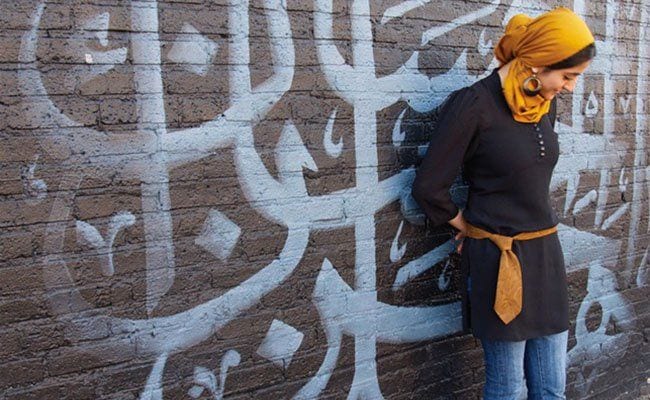
There is no doubt that Muslims are as much a part of American history as any other group that faces bias today, but Muslims and the Making of America (hereafter Muslims) does not make the case they deserve. Published in late 2016, the timeliness of Muslims‘ subject matter needs little explanation given the debate that was taking place (and continues to take place). However, it’s unclear what Muslims actually hoped to accomplish.
More than anything, the book is greatly disserved by its complete lack of references (other than a number of suggestions for further reading at the end). It’s hard to imagine any book intended for readers “both in and beyond academic institutions” that would have been green-lighted with so little attention to supporting its historical accounting. Although, it soon becomes clear, the historical accounting for a book dedicated to proving the influence of Islam in America is sorely under-researched.
From the beginning, the writing is awkwardly informal and prone to rambling, disconnected paragraphs with little attention to narrative. In the first chapter during the section devoted to African Muslim slaves and early America, Hussain spends hardly any time on the subject and the vast majority of its pages aimlessly recounting the drama of the “Ground Zero Mosque” from 2010 without even attempting to contrive a connection between the subject of the section and the discussion that follows. The section then abruptly ends with the self-satisfied “Muslims are part of the history of Lower Manhattan”, having said nothing about their connection other than reiterating an un-sourced statistic mentioned in the book’s introduction that ten percent of the slaves brought to America may have been Muslim. It becomes especially clear that Muslims demanded the skills of a more dedicated editor when parts of Chapter One are nearly copy-and-pasted verbatim from the Introduction, making for a difficult start to an already brief book.
Hussain writes with a very elementary syntax more suited to the style of a blog post than a published book. After recounting the plot of Alex Haley’s Roots (1976), Hussain writes, “Who knew that some of the slaves brought over from Africa were Muslims…?” His undisciplined writing style continually resurfaces throughout the book as when he spends an inexplicable amount of time discussing Islam’s understanding of Christ in a section devoted to the greatest Muslims in sports. His narrative about Kareem Abdul-Jabar strings together lazy, self-reinforcing assumptions more than source-supported facts. For Abdul-Jabar, Hussain once again drags out the ten percent statistic that goes forever unsourced but perpetually relied upon. This time, it is proof that conversion to Islam was not a conversion, at all, but a reversion, as Hussain sees it, to the ways of Abdul-Jabar’s ancestors (somewhere along the way the other 90 percent of non-Muslim slaves are completely disregarded).
Indeed, spending eight pages of 125 total on Kareem Abdul-Jabar seems bewildering. If the argument that “Islam has always been a part of America” rests so heavily on one or two figures, it’s a tough case to make. This is ultimately the most disappointing element of Muslims: the lack of preparation to write a book on this subject (in perhaps the timeliest moment in modern history) is stunning. By the end, the reader is left with a handful of factoids: Muslims may have comprised ten percent of the early slaves; a famous music producer was Muslim; as were two of the biggest names in sports. Does retelling Muhammad Ali’s and Kareem Abdul-Jabar’s very famous conversion stories actually make the case that Islam has always been a part of American history?
We are reminded that “there is also an older connection here between athletics and civil rights”, though the fact that that connection has to do with African-American civil rights, rather than Muslim American civil rights, is as usual entirely ignored. Hussain repeatedly wanders between African-American history and Muslim American history with only the most tangential, forced connections.
The lack of preparation aside, Hussain regularly stretches logic beyond all bounds, as when he discusses the circumambulation of “mourner’s benches” in African Methodist Episcopal Churches. Hussain’s conclusion? Muslims also circumambulate around the Ka’ba in Mecca. For Hussain, these are “subtle traces”, for anyone else it’s an entirely bizarre revelation that a religious studies professor wouldn’t acknowledge that circumambulation is an almost universal cultural and religious practice with no more specific connection to Islam than, say, Judaism or Christianity (i.e., the two religions that pre-date and lay a foundation for many Muslim doctrines).
By the time Hussain argues that the Trump Taj Mahal demonstrates the influence of Islam on America, it becomes impossible to believe he genuinely wants to make the case he outlines in the Introduction. In the chapter “Muslims on the American Landscape”, the influence of Islam on America has been exchanged for American “fascination with the Orient”, which Hussain shows us in the depiction of the camel mascot of Camel cigarettes.
It all begs the question: who is Hussain writing this book for? It is difficult (but troublingly possible) to imagine anyone so ignorant of American history not to have known that yes, Muhammad Ali and Kareem Abdul-Jabar were/are Muslim; yes, Muslims have lived in the United States for generations; yes, Islamic architecture and music have traveled to and influenced America. That’s how culture works: it doesn’t remain contained where it originated. For anyone seeking a thoughtful account of Islam in American history, however, unfortunatley, Muslims and the Making of America does not deliver.

